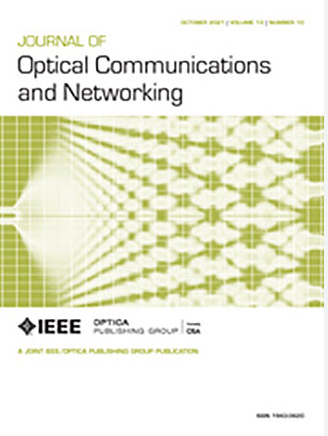Optical fiber anomaly detection through SRS-induced spectral tilt in C+L-band transmission systems
IF 4.3
2区 计算机科学
Q1 COMPUTER SCIENCE, HARDWARE & ARCHITECTURE
引用次数: 0
Abstract
Fiber-optic communication systems serve as the backbone of modern data communication networks, with increasing demands on their reliability and robustness in various emerging applications. A key challenge in ensuring reliable fiber-optic transmission lies in addressing fiber anomalies, which can cause signal degradation, service disruptions, and even system failures. However, the current anomaly detection method is too complex to be implemented in deployed networks or consumes too much time during detection. This paper proposes a simple and effective fiber anomaly detection method for C+L-band fiber-optic communication systems, leveraging the spectral tilt induced by the stimulated Raman scattering (SRS) effect. The method reconstructs the spectral tilt along an anomalous fiber link by analyzing the input and output power profile, easily obtainable from optical channel monitors (OCMs), enabling anomaly localization and loss quantification through forward and backward spectral tilt comparison. The performance and robustness of the proposed method are studied and discussed in actual scenarios such as erbium-doped fiber amplifier gain fluctuations, OCM measurement errors, parameter inaccuracies, and modeling inaccuracies. In addition to being able to detect a single anomaly, the process of using the proposed method to achieve multiple anomaly detection links is also discussed according to the chronological order of anomalies. Experimental validation on a multi-span C+L-band transmission system achieves a maximum localization error of 2.06 km and a maximum loss estimation error of 0.14 dB within 2 s. This work underscores the potential of exploiting inherent physical phenomena like SRS for fast anomaly detection in deployed optical networks.C+ l波段传输系统中srs诱导光谱倾斜的光纤异常检测
光纤通信系统作为现代数据通信网络的支柱,在各种新兴应用中对其可靠性和鲁棒性的要求越来越高。确保可靠的光纤传输的关键挑战在于解决光纤异常,这些异常可能导致信号退化、服务中断甚至系统故障。但是,目前的异常检测方法过于复杂,无法在已部署的网络中实现,或者检测耗时太长。本文提出了一种简单有效的C+ l波段光纤通信系统光纤异常检测方法,利用受激拉曼散射(SRS)效应引起的光谱倾斜。该方法通过分析从光通道监视器(ocm)容易获得的输入和输出功率分布,重建沿异常光纤链路的频谱倾斜,通过前向和后向光谱倾斜比较实现异常定位和损失量化。在掺铒光纤放大器增益波动、OCM测量误差、参数误差和建模误差等实际情况下,对该方法的性能和鲁棒性进行了研究和讨论。除了能够检测单个异常外,还根据异常的时间顺序讨论了使用该方法实现多个异常检测环节的过程。在多跨C+ l波段传输系统的实验验证中,2 s内最大定位误差为2.06 km,最大损耗估计误差为0.14 dB。这项工作强调了在部署的光网络中利用SRS等固有物理现象进行快速异常检测的潜力。
本文章由计算机程序翻译,如有差异,请以英文原文为准。
求助全文
约1分钟内获得全文
求助全文
来源期刊
CiteScore
9.40
自引率
16.00%
发文量
104
审稿时长
4 months
期刊介绍:
The scope of the Journal includes advances in the state-of-the-art of optical networking science, technology, and engineering. Both theoretical contributions (including new techniques, concepts, analyses, and economic studies) and practical contributions (including optical networking experiments, prototypes, and new applications) are encouraged. Subareas of interest include the architecture and design of optical networks, optical network survivability and security, software-defined optical networking, elastic optical networks, data and control plane advances, network management related innovation, and optical access networks. Enabling technologies and their applications are suitable topics only if the results are shown to directly impact optical networking beyond simple point-to-point networks.

 求助内容:
求助内容: 应助结果提醒方式:
应助结果提醒方式:


